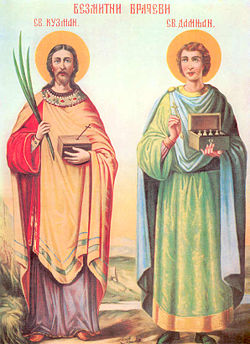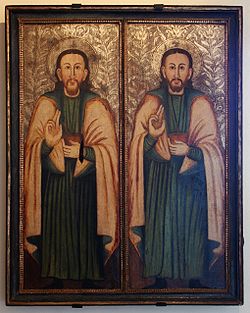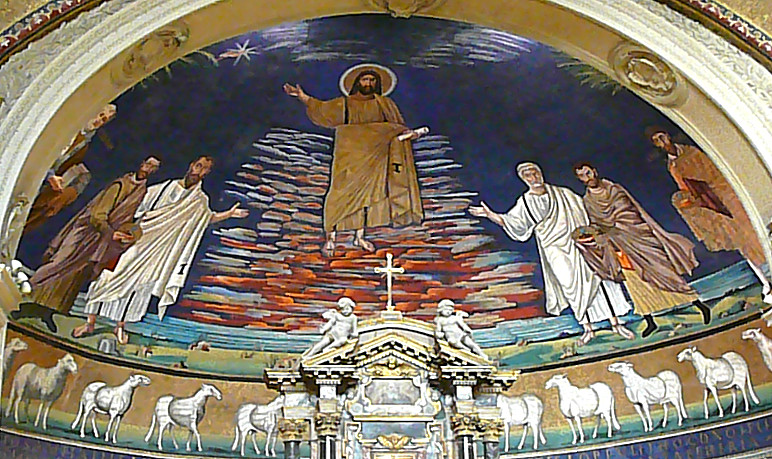Saints Cosmas and Damian
| Saints Cosmas and Damian | |
|---|---|
 Icon of Saints Cosmas (left) and Damian (right) holding medicine boxes and spoons for dispensing cures | |
| Martyrs | |
| Born | 3rd century AD Arabia |
| Died | c. 287 AD Aegea, Roman province of Syria |
| Honored in | Roman Catholic Church Eastern Orthodox Churches Oriental Orthodox Churches Eastern Catholic Churches |
| Major shrine | Convent of the Poor Clares in Madrid, Basilica of Saints Cosmas and Damian in Bitonto, Bari, Italy |
| Feast | September 26 September 27 (pre-1970 General Roman Calendar) Nov 1 (Eastern Orthodox Church) |
| Attributes | depicted as twins, beheaded, or with medical emblems |
| Patronage | surgeons, physicians, dentists, protectors of children, barbers, pharmacists, veterinarians, orphanages, day-care centers, confectioners, children in house, against hernia, against the plague. |
Saints Cosmas and Damian (Greek: Κοσμάς και Δαμιανός) (also written Kosmas and Damianos) (died ca. 287) were twin brothers, physicians, and early Christian martyrs born in Cilicia, part of today's Turkey. They practiced their profession in the seaport of Ayas, Adana, then in the Roman province of Syria. Accepting no payment for their services led to them being named "Ανάργυροι" (Unmercenary); it has been said that, by this, they attracted many to the Christian faith.[1]
Lives
[edit]

During the persecution under Diocletian, Cosmas and Damian were arrested by order of the Prefect of Cilicia, one Lysias who is otherwise unknown, who ordered them under torture to recant. However, according to legend they stayed true to their faith, enduring being hung on a cross, stoned and shot by arrows and finally suffered execution by beheading. Anthimus, Leontius and Euprepius, their younger brothers, who were inseparable from them throughout life, shared in their martyrdom.[2]
Their most famous miraculous exploit was the grafting of a leg from a recently deceased Ethiopian to replace a patient's ulcered leg, and was the subject of many paintings and illuminations.
Veneration
[edit]

As early as the 4th century, churches dedicated to the twin saints were established at Jerusalem, in Egypt and in Mesopotamia. Theodoret records the division of their relics. Their relics, deemed miraculous, were buried in the city of Cyrrus in Syria. Churches were built in their honor by Archbishop Proclus and by Emperor Justinian I (527–565), who sumptuously restored the city of Cyrus and dedicated it to the twins, but brought their relics to Constantinople; there, following his cure, ascribed to the intercession of Cosmas and Damian, Justinian, in gratitude also built and adorned their church at Constantinople, and it became a celebrated place of pilgrimage. At Rome Pope Felix IV (526–530) rededicated the Library of Peace (Bibliotheca Pacis) as a basilica of Santi Cosma e Damiano in the Forum of Vespasian in their honour. The church is much rebuilt but still famed for its sixth-century mosaics illustrating the saints.
What are said to be their skulls are venerated in the convent of the Clares in Madrid, where they have been since 1581, the gift of Maria, daughter of Emperor Charles V. They had previously been removed from Rome to Bremen in the tenth century, and thence to Bamberg (Matthews). Other skulls said to be theirs have been discovered at Easter 1334 by Burchard Grelle, Archbishop of Bremen. He "personally 'miraculously' retrieved the relics of the holy physicians Cosmas and Damian, which were allegedly immured and forgotten in the quire of the Bremen Cathedral.[2] In celebration of the retrieval Archbishop and Chapter arranged a feast at Pentecost 1335, when the relics were translated from the wall to a more dignified place." (For the original quotation see the note)[3] Grelle claimed the relics were those Archbishop Adaldag brought from Rome in 965. In about 1400 the cathedral master-builder Johann Hemeling commissioned a shrine for the relics, which has been accomplished until after 1420. The shrine from carved oak wood covered with gilt rolled silver is considered an important mediaeval gold work.[4] In 1649 Bremen's Chapter, meanwhile Lutheran, sold the shrine without the heads to Maximilian I of Bavaria. The Heads remains in Bremen, why in Munich they have had two heads from Bamberg and Emnporer Heinrich. The two heads remained in Bremen and came in the posession of the small catholic comunity. They have been shown last time from 1934 to 1968 in the Church of St. Johann and burried 1994 under the bottom of the crypt. (Wilhelm Tacke: St. Johann in Bremen - erine 600jährige Geschichte - von den Bettelbrüdern bis zu den Pröpsten, Bremen 2006, S. 172ff.) It is now shown in the Jesuit church of St Michael in Munich. At least since 1413 another pair of skulls is stored in St Stephens's Cathedral in Vienna. Other relics are claimed by the Church of San Giorgio Maggiore in Venice.
The martyr twins are invoked in the Canon of the Mass in the prayer known as the Communicantes (from the first Latin word of the prayer): "In communion with the whole Church, they venerate above all others the memory of the glorious ever-virgin Mary, Mother of our God and Lord, Jesus Christ, then of blessed Joseph, husband of the Virgin, your blessed Apostles and Martyrs, Peter and Paul, Andrew, James, John, Thomas, James, Philip, Bartholomew, Matthew, Simon and Jude: Linus, Cletus, Clement, Sixtus, Cornelius, Cyprian, Laurence, Chrysogonus, John and Paul, Cosmas and Damian and all your Saints: grant through their merits and prayers that in all things we may be defended by the help of your protection." They are also invoked in the Litany of the Saints.

Their feast day in the Roman Catholic calendar of saints, which had been on September 27, was moved in 1969 to September 26, because September 27 is the dies natalis ("day of birth" into Heaven) of Saint Vincent de Paul, now more widely venerated in the Latin Church,[5] but some traditionalist Catholics continue to observe the pre-1970 calendar.
Sts Cosmas and Damian are regarded as the patrons of physicians and surgeons and are sometimes represented with medical emblems.
Sir William Hamilton (1730–1803)[6] reported that, among the wax representations of body parts then presented as offerings to the two doctor saints at Isernia, near Naples, on their feast day, those of the penis were the most common.[7] They were in fact venerated as patrons of "young girls anxious for a husband, and married women desirous of children."[8]
In Brazil, the twin saints are regarded as protectors of children, and September 27 is commemorated, especially in Rio de Janeiro, by giving children bags of candy with the saints' effigy printed on them and throughout the entire state of Bahia where catholics and adepts of candomblé religion offer typical food such as carurú. The ritual consists of first offering the food to seven children that are no older than seven years old and have them feast while sitting on the floor and eat with their hands. Only after all children have finished can the guests enjoy the food that is being offered. Saint Cosmas and Damian Church, in Igarassu, Pernambuco is Brazil's oldest church, built in 1535.
In the UK St Damian is the dexter side support of the arms of the British Dental Association.
Eastern Christianity
[edit]
In the Eastern Orthodox Church, Eastern Catholic Churches, and the Oriental Orthodox Churches, Saints Cosmas and Damian are venerated as a type of saint known as Unmercenary Physicians (Greek: ἀνάργυροι, anargyroi, "without money"). This classification of saints is unique to the Eastern Church and refers to those who heal purely out of love for God and man, strictly observing the command of Jesus: "Freely have you received, freely give." («Δωρεὰν ἐλάβετε, δωρεὰν δότε...» Matthew 10:8) While each of the Unmercenaries have their own feast days, all are commemorated together on the first Sunday in November, in a feast known as the Synaxis of the Unmercenary Physicians.
The Orthodox celebrate no less than three different sets of saints by the name of Cosmas and Damian, each with its own distinct feast day:
- Saints Cosmas and Damian of Cilicia (Arabia) (October 17) Brothers, they were beaten and beheaded together with three other Christians: Leontius, Anthimus, and Eutropius.
- Saints Cosmas and Damian of Asia Minor — alternately, of Mesopotamia (November 1) Twin sons of Saint Theodota. Died peacefully and were buried together at Thereman in Mesopotamia.
- Saints Cosmas and Damian of Rome (July 1) Brothers, they were martyred outside Rome by a jealous pagan physician during the reign of the Roman Emperor Carinus (283–284).
Orthodox icons of the saints depict them vested as laymen holding medicine boxes. Often each will also hold a spoon with which to dispense medicine. The handle of the spoon is normally shaped like a cross to indicate the importance of spiritual as well as physical healing, and that all cures come from God.
In Russia since 17th century there was a priestly Kosmodemyansky family. Their family name was constructed by joining the names of Saints Cosmas and Damian (Kosma and Demyan in Russian). The family includes Saint Pyotr Kosmodemyansky (1872–1918), a priest murdered by militant atheists for his opposition to blasphemy, and his granddaughter Zoya Kosmodemyanskaya (1923–1941), the most revered martyr of the Soviet Union.
In Rochester, MN, home of the Mayo Clinic, the Greek Orthodox Church is the [http://www.holyanargyroi.org Holy Anargyroi/Sts. Kosmas & Damianos Greek Orthodox Church

Church of England
[edit]In the Church of England, dedications of churches to SS Cosmas and Damian are very rare:
- Blean, Kent, church of St Cosmus [sic] and St Damian in the Blean;
- Challock, Kent;
- Keymer, Sussex, St Cosmas and St Damian Church, Keymer;
- Sherrington, Wiltshire, church of St Cosmo [sic] and St Damian, in the Benefice of the Upper Wylye Valley;
- Stretford, near Leominster, Herefordshire, church no longer in use and in the care of the Churches Conservation Trust.
References
[edit]- ^ Catholic Encyclopedia: "Sts. Cosmas and Damian"
- ^ Jump up to: a b Cf. "Bremer Chronik von Gerhard Rinesberch und Herbord Schene", In: Bremen, Hermann Meinert (ed.) on behalf of the Historische Kommission bei der Bayerischen Akademie der Wissenschaften, Bremen: Schünemann, 1968, (Chroniken der deutschen Städte vom 14. bis ins 16. Jahrhundert; vol. 37: Die Chroniken der niedersächsischen Städte), p. 112,; Regesten der Erzbischöfe von Bremen, Joseph König and Otto Heinrich May (compilators), Hanover: Selbstverlag der Historischen Kommission, 1971, (Veröffentlichungen der Historischen Kommission für Hannover, Oldenburg, Braunschweig, Schaumburg-Lippe und Bremen; vol. 11,2,2), vol. 2, Lfg. 2: 1327–1344, No. 508; Joseph König, "Zur Biographie des Burchard Grelle, Erzbischof von Bremen und der Geschichte seines Pontifikats (1327–1344)", In: Stader Jahrbuch; vol. 76 (1986), p. 42; Herbert Schwarzwälder, Geschichte der Freien Hansestadt Bremen:5 vols., ext. and impr. ed., Bremen: Ed. Temmen, 1995, vol. 1: Von den Anfängen bis zur Franzosenzeit: (1810), p. 70; Alfred Löhr, "Kult und Herrschaft, Erzstift und Domkapitel", In: Der Bremer Dom. Baugeschichte, Ausgrabungen, Kunstschätze. Handbuch u. Katalog zur Sonderausstellung vom 17.6. bis 30.9.1979 im Bremer Landesmuseum - Focke-Museum -, Karl Heinz Brandt (ed.), Bremen: Bremer Landesmuseum, 1979, (Focke-Museum, Bremen. Hefte; No. 49, vielm.: 52), pp. 102seq. and 128 as well as Catalogue No. 31, Urkunden und Siegel des Erzbischofs Burchard Grelle; Bodo Heyne, "Die Arztheiligen Kosmas und Damian und der Bremer Dom", In: Hospitium Ecclesiae: Forschungen zur Bremischen Kirchengeschichte; vol. 9 (1975), pp. 7–21; Johannes Focke, "Die Heiligen Cosmas und Damian und ihr Reliquienschrein im Dom zu Bremen", In: Bremisches Jahrbuch, Bd. 17 (1895), pp. 128–161.
- ^ "Ostern 1334 hatte Burchard persönlich im Chor des Bremer Doms die … dort angeblich eingemauerten und vergessenen Reliquien der heiligen Ärzte Cosmas und Damian auf 'wunderbare Weise' wiederaufgefunden. Erzbischof und Kapitel veranstalteten aus diesem Anlaß zu Pfingsten 1335 ein Fest, bei dem die Reliquien aus der Mauer an einen würdigeren Platz überführt wurden." Konrad Elmshäuser, "Der werdende Territorialstaat der Erzbischöfe von Bremen (1236–1511): I. Die Erzbischöfe als Landesherren", In: Geschichte des Landes zwischen Elbe und Weser: 3 parts, Hans-Eckhard Dannenberg and Heinz-Joachim Schulze (eds.) on behalf of the Landschaftsverband der ehemaligen Herzogtümer Bremen und Verden, Stade: Landschaftsverband der ehem. Herzogtümer Bremen und Verden, 1995 and 2008, (Schriftenreihe des Landschaftsverbandes der ehem. Herzogtümer Bremen und Verden; No. 7), part II: Mittelalter (1995), pp. 159–189, here p. 177. Original emphasis. Omission not in the original. ISBN 978-3-9801919-8-2
- ^ Konrad Elmshäuser, "Der werdende Territorialstaat der Erzbischöfe von Bremen (1236–1511): I. Die Erzbischöfe als Landesherren", In: Geschichte des Landes zwischen Elbe und Weser: 3 parts, Hans-Eckhard Dannenberg and Heinz-Joachim Schulze (eds.) on behalf of the Landschaftsverband der ehemaligen Herzogtümer Bremen und Verden, Stade: Landschaftsverband der ehem. Herzogtümer Bremen und Verden, 1995 and 2008, (Schriftenreihe des Landschaftsverbandes der ehem. Herzogtümer Bremen und Verden; No. 7), Part II: Mittelalter (1995), pp. 159–189, here p. 178. ISBN 978-3-9801919-8-2
- ^ "Calendarium Romanum" (Libreria Editrice Vaticana, 1969), p. 140
- ^ Sir William Hamilton was the husband of Emma, Lady Hamilton, the mistress of Horatio Nelson.
- ^ Whitney Davis, "Wax Tokens of Libido"
- ^ Hodder M. Westropp (1870-04-05). "Phallic Worship". ANTHROPOLOGICAL SOCIETY OF LONDON. Retrieved 31 August 2009.
Further reading
[edit]- Acta sanctorum, 27 Sept, p 432 para 187
External links
[edit]- Catholic Encyclopedia:Sts. Cosmas and Damia
- Leslie G. Matthews, "SS. Cosmas and Damian—Patron Saints of Medicine and Pharmacy: Their Cult in England" in Medical History: notes on the few English churches dedicated to these saints
- Wonderworkers and Unmercenaries Cosmas and Damian of Asia Minor (November 1) Eastern Orthodox icon and synaxarion
- Holy Wonderworking Unmercenary Physicians Cosmas and Damian at Rome (July 1)
- Martyrs and Unmercenaries Cosmas Damian in Cilicia (October 17)
- Synaxis of the Holy Unmercenaries Icon
- Representations of Saints Cosmas and Damian
- Saints Cosmas and Damian page at Christian Iconography
- "Here Follow the Lives of Saints Cosmo and Damian" from the Caxton translation of the Golden Legend
el:Κοσμάς και Δαμιανός hr:Sveti Kuzma i Damjan it:Cosma e Damiano ka:კოზმა და დამიანე (IV) sw:Cosmas Mtakatifu kv:Кузьма-Демьян лун la:Cosmas et Damianus hu:Szent Kozma és Damján no:Kosmas og Damian pt:Cosme e Damião sc:Gòsamu e Damianu sk:Svätí Kozma a Damián sl:Sveti Kozma in Damijan sh:Sveti Kuzma i Damjan vo:Santi Cosma e Damiano
- Pages using the JsonConfig extension
- Articles with hatnote templates targeting a nonexistent page
- Missing redirects
- Articles containing Greek-language text
- Persondata templates without short description parameter
- 3rd-century births
- 287 deaths
- Ancient Roman physicians
- Christian martyrs of the Roman era
- Eastern Orthodox saints
- Unmercenaries
- Syrian saints
- Syrian Roman Catholic saints
- Saints duos
- Twin people
- Articles about multiple people
- Saints of the Golden Legend
- 3rd-century Christian martyr saints
